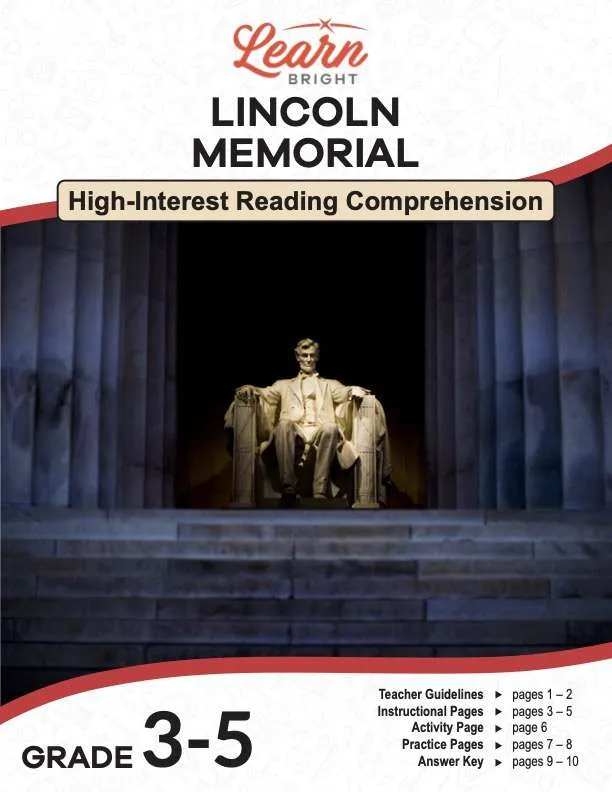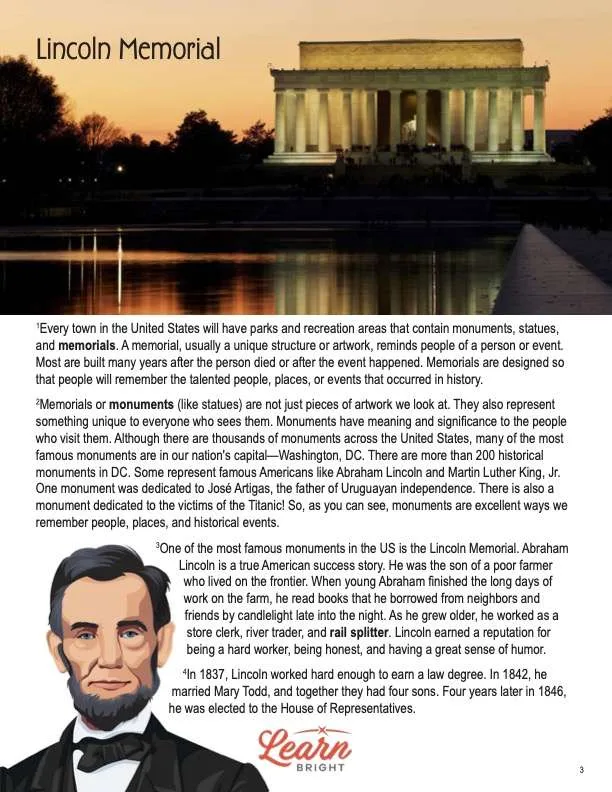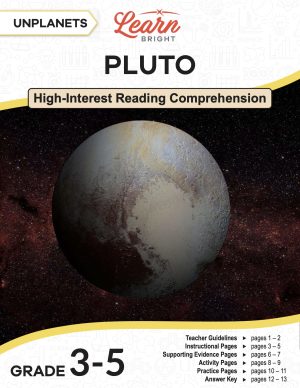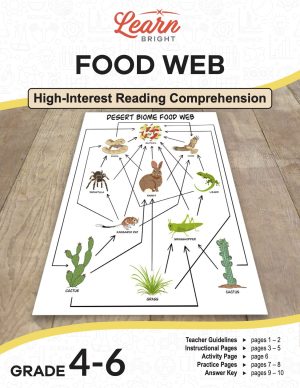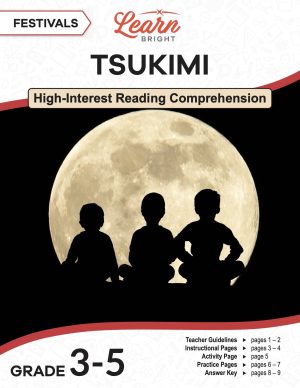Description
What our Lincoln Memorial lesson plan includes
Lesson Objectives and Overview: Lincoln Memorial is a high-interest reading comprehension lesson plan. As such, students will practice various close reading and comprehension skills while learning about the history and significance of this important structure. This lesson is for students in 3rd grade, 4th grade, and 5th grade.
Classroom Procedure
Every lesson plan provides you with a classroom procedure page that outlines a step-by-step guide to follow. You do not have to follow the guide exactly. The guide helps you organize the lesson and details when to hand out worksheets. It also lists information in the yellow box that you might find useful. You will find the lesson objectives, state standards, and number of class sessions the lesson should take to complete in this area. In addition, it describes the supplies you will need as well as what and how you need to prepare beforehand. The activity in this lesson requires video recorders and access to the internet.
Teacher Notes
The teacher notes page provides an extra paragraph of information to help guide the lesson. It explains that you can teach this lesson in a whole-class setting or as an independent, small-group activity. You can use the blank lines to write down any other ideas or thoughts you have about the topic as you prepare.
LINCOLN MEMORIAL LESSON PLAN CONTENT PAGES
Memorials and Monuments
The Lincoln Memorial lesson plan contains three content pages. Every town in the United States will have parks and recreation areas that contain monuments, statues, and memorials. A memorial, usually a unique structure or artwork, reminds people of a person or event. Most are built many years after the person died or after the event happened. Memorials are designed so that people will remember the talented people, places, or events that occurred in history.
Memorials or monuments (like statues) are not just pieces of artwork we look at. They also represent something unique to everyone who sees them. Monuments have meaning and significance to the people who visit them. Although there are thousands of monuments across the United States, many of the most famous monuments are in our nation’s capital—Washington, DC.
There are more than 200 historical monuments in DC. Some represent famous Americans like Abraham Lincoln and Martin Luther King, Jr. One monument was dedicated to José Artigas, the father of Uruguayan independence. There is also a monument that honors the victims of the Titanic! So, as you can see, monuments are excellent ways we remember people, places, and historical events.
Abraham Lincoln
One of the most famous monuments in the US is the Lincoln Memorial. Abraham Lincoln is a true American success story. He was the son of a poor farmer who lived on the frontier. When young Abraham finished the long days of work on the farm, he read books that he borrowed from neighbors and friends by candlelight late into the night. As he grew older, he worked as a store clerk, river trader, and rail splitter. Lincoln earned a reputation for being a hard worker, being honest, and having a great sense of humor.
In 1837, Lincoln worked hard enough to earn a law degree. In 1842, he married Mary Todd, and together they had four sons. Four years later in 1846, he was elected to the House of Representatives. Interesting fact: While in Washington, Lincoln attended the opening ceremonies to lay the cornerstone to what would later become another famous monument, the Washington Monument. The Lincoln Memorial sits across from the Washington Monument.
By now, you know the rest of the story. The American people elected Abraham Lincoln as the 16th president of the United States in 1860. We know him best for the Emancipation Proclamation, which freed enslaved people. Under his leadership, Lincoln steered the country during the Civil War, leading the Union to victory over the Confederacy and ending enslavement in the United States forever.
His calm demeanor and willingness to compromise helped heal the war-torn nation and reunite the North and South into one country. Unfortunately, Lincoln was assassinated in April of 1865, in the middle of his second presidential term. Congress began work to create a memorial to remember his patriotism two years after his death.
The Lincoln Memorial
In March of 1867, Congress created a commission to design and build the memorial. It would be another 43 years—1910—before Congress would pass a bill that allowed work to begin on the Lincoln Memorial! It took another 12 years to complete the project from the day of the design and construction. In 1922, President Harding and Chief Justice of the Supreme Court Robert Taft officially accepted the memorial on behalf of the American people. Robert Todd Lincoln attended the ceremony, the only surviving son of Abraham and Mary. He was 78 years of age.
Ironically, although many African Americans were invited and attended the event, they were moved to a segregated area near the monument. The very people Lincoln had fought so strongly to free still faced racial discrimination nearly 60 years after the Civil War ended in 1865.
Today, the Lincoln Memorial stands for more than a tribute to the memory of President Lincoln. It has become a monument to civil rights, racial equality, and justice for all Americans. Millions of people visit this most famous memorial in Washington every year. The monument commemorates one of the most outstanding leaders in American history. It is now an enduring symbol of the American ideal of democracy, freedom, and social justice for future generations.
Cool Facts
The last content page lists lots of interesting facts about the memorial. The building’s theme represents the Union. At the time of Lincoln’s death, there were 36 Union States, so the memorial has 36 columns to represent each state. Carved in the stone on the outside of the building is the name of the 48 states that were in the Union when the monument was completed. A plaque was later added with Hawaii and Alaska.
Lincoln is seated and facing toward the Washington Monument. The Gettysburg Address and Second Inaugural Address of 1865 are engraved on the inside walls. In 1922, a reflecting pool was added. The pool is between the Lincoln Memorial and the Washington Monument. The Washington Monument reflects off the pool.
The statue of Lincoln was originally supposed to be 10 feet in height. The completed statue is 19 feet high and weighs nearly 175 tons. On the back of a penny and five-dollar bill, the statue of the Lincoln Memorial is in the background. You have to look closely as it is very tiny!
There is a misspelled word engraved on the wall. It reads EUTURE but should read FUTURE. It has been corrected. You can see where the first E turned into an F. A former Confederate—Lt. Colonel Joseph Blackburn—turned the first shovelful of soil in the construction project.
At 4 a.m. in the morning, President Nixon debated with Vietnam War protesters in front of the monument. Murals portray Lincoln’s principles: Freedom, Liberty, Immortality, Justice, the Law, Unity, Fraternity, and Charity. Finally, there is a 43,000-square-foot basement under the memorial being restored. Workers left cartoons and graffiti on the walls.
LINCOLN MEMORIAL LESSON PLAN WORKSHEETS
The Lincoln Memorial lesson plan includes two worksheets: an activity worksheet and a practice worksheet. Each one will help students solidify their grasp of the material they learned throughout the lesson. You can refer to the classroom procedure guidelines to know when to hand out each worksheet.
WHAT DOES IT MEAN ACTIVITY WORKSHEET
For the activity, students will read Lincoln’s Gettysburg Address, which is inscribed in the Lincoln Memorial. They will write what they believe each of the three paragraphs mean or what they think Lincoln was trying to say.
LINCOLN MEMORIAL PRACTICE WORKSHEET
The practice worksheet requires students to answer a series of 11 questions. These questions all relate to the content pages, so students will need to refer to them often for the answers. In addition, each question provides which reading tool the question corresponds to, such as text feature, vocabulary, or comprehension.
Worksheet Answer Keys
At the end of the lesson plan document is an answer key for the practice worksheet. The correct answers are all in red to make it easier for you to compare them with students’ responses. If you choose to administer the lesson pages to your students via PDF, you will need to save a new file that omits these pages. Otherwise, you can simply print out the applicable pages and keep these as reference for yourself when grading assignments.

